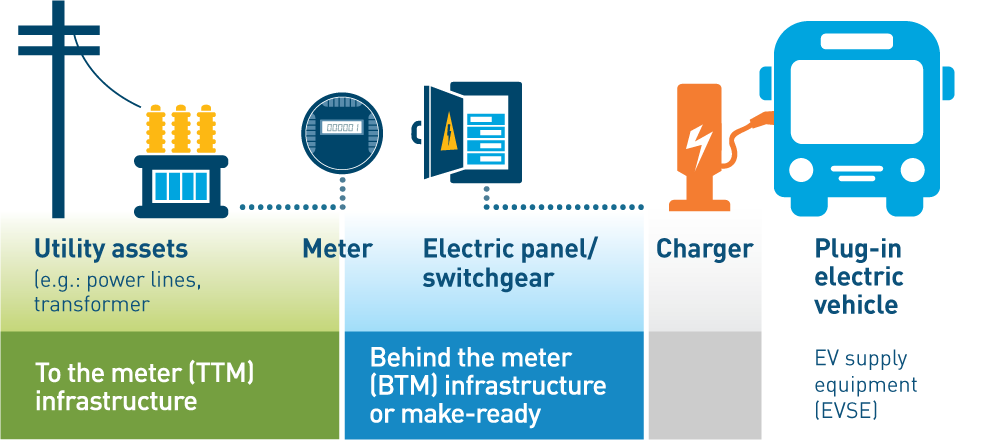Error: Field cannot left blank.
Error: Invalid entry. Do not use equal signs [=] or colons [:].
Error: Field cannot left blank.
Error: Invalid entry. Do not use equal signs [=] or colons [:].
Overview

PG&E's EV Fleet program helps fleets easily and cost-effectively install charging infrastructure so they can:
- Save money
- Eliminate tailpipe emissions
- Simplify maintenance
EV Fleet is a comprehensive program that encompasses:
- Incentives and rebates
- Site design and permitting
- Construction and activation
PG&E’s EV Fleet program aims to help:
- 700+ sites convert their fleets to electric
- 6,500+ electric vehicles be deployed across numerous medium- and heavy-duty fleet sectors
Want to learn more?
Watch our 3-minute video for an overview.
Benefits of fleet electrification
Save money
EVs are 4X more efficient than diesel and natural gas engines and offer significant fuel cost savings.1 Plus, you can take advantage of infrastructure incentives available through the EV Fleet program.
Eliminate tailpipe emissions
Electric vehicles have zero tailpipe emissions and a smaller carbon footprint than conventional vehicles, which means cleaner air for your community and fewer greenhouse gasses from your fleet.
Simplify maintenance
Electric vehicles have fewer and less complex parts, which simplifies maintenance, results in less down time, and lowers overall lifetime operation and maintenance costs.
Demonstrate leadership
Your company can help lead the way to a cleaner, greener California and be a good environmental steward.
Get ahead
Take advantage of PG&E incentives while getting a jump start on regulatory requirements like California’s Advanced Clean Fleets Rule.
Support California’s goals
Transportation is the single largest source of climate-related pollution.2 Fleet electrification is critical to helping the state reach its greenhouse gas reduction goals in 2030 and 2050.
1 Union of Concerned Scientists and the Greenlining Institute, May 2017
2 California Air and Resources Board (CARB), July 2018
Incentives and rebates
PG&E offers infrastructure incentives and charger rebates to offset costs.

Through the EV Fleet Program, PG&E will construct, own and maintain all electrical infrastructure up to the customer’s meter.
Fleet operators will design, build, own, operate, and maintain the electrical infrastructure from the customer meter to the EV charger. In select instances, PG&E may also cover this portion of the work.*
*Incentives limited to 25 vehicles per site; sites with more vehicles to be considered on an individual basis.
*Charging equipment rebates for school buses, transit buses and sites in disadvantaged communities. Rebate not to exceed 50% of charger equipment. EVSE must meet minimum and standard requirements to be eligible for rebate. Fortune 1000 companies are not eligible.
Additional savings opportunities
Our team can help you explore the estimated costs for converting to an electric fleet, as well as additional savings opportunities available from other funding sources. Use the tools below as a first step.
Fuel Switching Rate Calculator
To find out how moving to an electric fleet will impact your rates, use our fuel switching rate calculator to see what savings opportunities you might be eligible to receive. Learn more on the Business EV rates page.
Eligibility requirements
Industries supported
The EV Fleet program supports all off-road, medium-duty and heavy-duty vehicle applications, such as:
- Agriculture and food processing
- Distribution and delivery
- Municipal fleets
- School buses
- Transit, coach and shuttle buses
- Work trucks and utility vehicles
Unsure if your fleet qualifies? Submit an interest form and a PG&E representative will review your eligibility.
To be eligible for the EV Fleet program, you are required to:
Be a PG&E electric customer
This includes Direct Access and retail customers, as well as customers receiving power from a Community Choice Aggregator.
Own or lease the property
Your organization must have the authority to install charging infrastructure at your site.
In addition, all properties require an easement allowance (PDF) for their EV Fleet projects.
Acquire at least 2 EVs
Your organization must acquire and deploy a minimum of two medium- or heavy-duty electric fleet vehicles over the next 5 years.
Agree to all requirements
Review and agree to the EV Fleet program terms and conditions (PDF)
Plan to purchase vehicles in the future?
Many customers have long-term fleet electrification plans but may only be able to purchase a handful of vehicles today. The EV Fleet Program will provide infrastructure for all eligible vehicles that are being deployed over the next 5 years. Customer must have their 5-year vehicle and charging plan ready before applying to the program and must be willing to commit to this plan in the EV Fleet contract.
Funding requirements
If your fleet receives funding through the EV Fleet program, you will be required to:
- Provide data related to EV usage - Your organization must provide EV usage data for at least 5 years after the chargers are installed and operational.
- Make a 10-year commitment - Your organization must agree to operate and maintain the EV charging equipment for at least 10 years.
Interested in the EV Fleet program?
Take the first step to electrify your fleet.
Sectors
Distribution and delivery fleets
Fleets that transport goods to and from import/export facilities, warehouses, distribution centers, retail complexes, etc.
Shuttle bus fleets
Corporate campuses, universities, hotels, car parks, airport shuttle services, hospitals, etc.
School bus fleets
Public schools and organizations that operate buses to transport K-12 school children.
Transit fleets
Transit agencies that operate buses and shuttles to transport people.
Municipal fleets
Cities that operate a diverse range of medium- and heavy-duty vehicles which serve the various needs of a community.
Different business sector
If your business sector is not mentioned above, you may still be eligible for the EV Fleet Program. Contact us to find out.
Webinars
- Program overview: Watch this recorded webinar for an overview of PG&E's EV Fleet program. Learn how you can save money, eliminate tailpipe emissions, and simplify maintenance.
- Stacking incentives: Watch this recorded webinar for an overview on all available federal, state and regional funding opportunities available for deploying zero emission vehicles. PG&E has coordinated with multiple funding agencies to simplify and maximize customer benefit.
- EV Fleet Savings Calculator: Learn how to use the EV Fleet Savings Calculator tool to better understand key total cost of ownership inputs, including incentives, energy costs, and infrastructure considerations.
- Total cost of ownership: Understand the costs (and cost-savings) involved with deploying EVs. Fleets that are used to managing conventional vehicles and fuels may miss key budgeting considerations that can make or break an EV project.
- Choosing the right EVSE hardware: For any fleet considering a transition to electric, choosing the appropriate EVSE hardware is a critical initial step.
- Managing EV charging costs: Hear from two charging infrastructure providers to learn about the software available to optimize and manage charging cycles and costs.
- Charging infrastructure design: Design your charging infrastructure to accommodate short- and long-term needs. Learn more about the benefits of working with PG&E and an electrical contractor early.
- Generating revenue with LCFS: Learn how fleets in California can generate additional revenue by operating electric vehicles and equipment through the state’s Low Carbon Fuel Standard (LCFS) program.
- Creating a competitive funding application: Learn how fleets can create competitive funding applications to secure grants and incentives that buy down the cost of transportation electrification.
- Resiliency planning for EVs: Developing an energy plan that considers resiliency and accounts for needs 5 to 10 years from now helps mitigate unexpected infrastructure cost.
- Permitting for EVs: Installing EV charging infrastructure requires building permits to begin site construction. Learn about the process and requirements to obtain site permits, as well as the anticipated construction timelines.
Frequently asked questions
Find more information on the program about participation, vendors and contractors, charging infrastructure, energy usage and more.
More EV resources
EV Fleet Charging Guidebook
Learn about charger selection, site planning, understanding electricity costs and more.
EV Fleet Savings Calculator
To find out how moving to an electric fleet will impact your rates, use our rate calculator to see what rates and savings opportunities you might be eligible to receive.
Approved charging product list
You can select EV charger options from our approved product list (hosted by Southern California Edison) and receive a rebate of up to 50% of the cost for eligible chargers.
Terms & Conditions
To participate in EV Fleet, you must agree to abide by the terms and conditions of the program.
Offer Letter & Contract
To move your project into the design phase and begin the engineering, design and construction plans, you must first complete the offer letter and contract.
Electrification process
Learn about the step-by-step process to fleet electrification.
Check grid capacity
Find grid capacity information to help with site selection.
Information for dealerships
Learn how dealers can boost EV sales by referring customers to EV Fleet.
Behind the Meter (BTM) Infrastructure Design Guidance
Learn how to find a qualified professional to design your BTM infrastructure.
©2024 Pacific Gas and Electric Company
©2024 Pacific Gas and Electric Company

